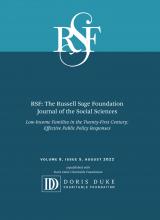Research Article
Open Access
Making Sense of Childcare Instability Among Families with Low Incomes: (Un)desired and (Un)planned Reasons for Changing Childcare Arrangements
Alejandra Ros Pilarz, Heather Sandstrom, Julia R. Henly
RSF: The Russell Sage Foundation Journal of the Social Sciences August 2022, 8 (5) 120-142; DOI: https://doi.org/10.7758/RSF.2022.8.5.06
Alejandra Ros Pilarz
aAssistant professor at the Sandra Rosenbaum School of Social Work at the University of Wisconsin–Madison, United States
Heather Sandstrom
bSenior fellow in the Center on Labor, Human Services, and Population at the Urban Institute in Washington, D.C., United States
Julia R. Henly
cProfessor at the University of Chicago Crown Family School of Social Work, Policy, and Practice, United States

REFERENCES
- ↵
- Adams, Gina, and
- Monica Rohacek
- ↵
- Ananat, Elizabeth O.,
- Anna Gassman-Pines, and
- John A. Fitz-Henley II.
- ↵
- ↵
- Bratsch-Hines, Mary E.,
- Robert Carr,
- Eleni Zgourou,
- Lynne Vernon-Feagans, and
- Michael Willoughby
- ↵
- Bratsch-Hines, Mary E.,
- Irina Mokrova, and
- Lynne Vernon-Feagans and the Family Life Project Key Investigators
- ↵
- Carlson, Marcia J.,
- Christopher Wimer, and
- Ron Haskins
- ↵
- Carrillo, Dani,
- Kristen Harknett,
- Allison Logan,
- Sigrid Luhr, and
- Daniel Schneider
- ↵
- Chaudry, Ajay
- ↵
- Crosnoe, Robert,
- Kate Chambers Prickett,
- Chelsea Smith, and
- Shannon Cavanagh
- ↵
- Cross, Christina J
- ↵
- ↵
- Fiese, Barbara H.,
- Thomas J. Tomcho,
- Michael Douglas,
- Kimberly Josephs,
- Scott Poltrock, and
- Tim Baker
- ↵
- Friese, Sarah,
- Van-Kim Lin,
- Nicole Forry, and
- Kathryn Tout
- ↵
- Ha, Yoonsook,
- Katherine Magnuson, and
- Marci Ybarra
- ↵
- Harknett, Kristen,
- Daniel Schneider, and
- Sigrid Luhr
- ↵
- Heggeness, Misty L
- ↵
- Henly, Julia R., and
- Gina Adams
- ↵
- Henly, Julia R.,
- Jaeseung Kim,
- Heather Sandstrom,
- Alejandra Ros Pilarz, and
- Amy Claessens
- ↵
- Henly, Julia R., and
- Sandra Lyons
- ↵
- Henly, Julia R.,
- Heather Sandstrom,
- Amy Claessens,
- Alejandra Ros Pilarz,
- Julia Gelatt,
- Jaeseung Kim, and
- Olivia Healy
- ↵
- Henly, Julia R.,
- Heather Sandstrom, and
- Alejandra Ros Pilarz
- ↵
- Howell, David R., and
- Arne L. Kalleberg
- ↵
- ↵
- Joshi, Pamela,
- Abigail N. Walters,
- Clemens Noelke, and
- Dolores Acevedo-Garcia
- ↵
- Kochhar, Rakesh
- ↵
- Krafft, Caroline,
- Elizabeth E. Davis, and
- Kathryn Tout
- ↵
- Lambert, Susan J.,
- Julia R. Henly, and
- Jaeseung Kim
- ↵
- Lowe, Edward D., and
- Thomas S. Weisner
- ↵
- Lowe, Edward D.,
- Thomas S. Weisner, and
- Sonya Geis
- ↵
- Luhr, Sigrid,
- Daniel Schneider, and
- Kristen Harknett
- ↵
- Malik, Rasheed,
- Katie Hamm,
- Leila Schochet,
- Cristina Novoa,
- Simon Workman and
- Steven Jessen-Howard
- ↵
- McLoyd, Vonnie C
- ↵
- Michelmore, Katherine M., and
- Natasha V. Pilkauskas
- ↵
- Miles, Matthew, and
- A. Michael Huberman
- ↵
- Miller, Cynthia
- ↵
- Moran, Kaitlin K
- ↵
- National Survey or Early Care and Education Project Team (NSECE)
- ↵
- NICHD Early Child Care Research Network (NICHD)
- ↵
- Pacheco-Applegate, Aida,
- Erin Devorah Carreon,
- Emily Ellis,
- Whitney Clarke Thomas,
- Julia R. Henly,
- Julie Spielberger, and
- Marci Ybarra
- ↵
- Pager, Devah, and
- Hana Shepherd
- ↵
- Pilarz, Alejandra Ros,
- Amy Claessens, and
- Julia Gelatt
- ↵
- Pilarz, Alejandra Ros, and
- Heather D. Hill
- ↵
- Pilarz, Alejandra Ros, and
- Heather D. Hill
- ↵
- Pilkauskas, Natasha V., and
- Christina Cross
- ↵
- Quillian, Lincoln,
- Devah Pager,
- Ole Hexel, and
- Arnfinn H. Midtbøen
- ↵
- Ryan, Gery W., and
- H. Russell Bernard
- ↵
- Sandstrom, Heather, and
- Ajay Chaudry
- ↵
- Sandstrom, Heather, and
- Sandra Huerta
- ↵
- Schochet, Leila
- ↵
- ↵
- Scott, Ellen K.,
- Andrew S. London, and
- Allison Hurst
- ↵
- Shonkoff, Jack P., and
- Deborah A. Phillips
- ↵
- Smith, Ember, and
- Richard V. Reeves
- ↵
- Speirs, Katherine,
- Colleen Vesely, and
- Kevin Roy
- ↵
- Storer, Adam,
- Daniel Schneider, and
- Kristen Harknett
- ↵
- Weber, Roberta B
- ↵
- White House
- ↵
- Yeung, W. Jean,
- Miriam R. Linver, and
- Jeanne Brooks-Gunn
In this issue
Making Sense of Childcare Instability Among Families with Low Incomes: (Un)desired and (Un)planned Reasons for Changing Childcare Arrangements
Alejandra Ros Pilarz, Heather Sandstrom, Julia R. Henly
RSF: The Russell Sage Foundation Journal of the Social Sciences Aug 2022, 8 (5) 120-142; DOI: 10.7758/RSF.2022.8.5.06
Making Sense of Childcare Instability Among Families with Low Incomes: (Un)desired and (Un)planned Reasons for Changing Childcare Arrangements
Alejandra Ros Pilarz, Heather Sandstrom, Julia R. Henly
RSF: The Russell Sage Foundation Journal of the Social Sciences Aug 2022, 8 (5) 120-142; DOI: 10.7758/RSF.2022.8.5.06
Jump to section
Related Articles
- No related articles found.
Cited By...
- No citing articles found.





